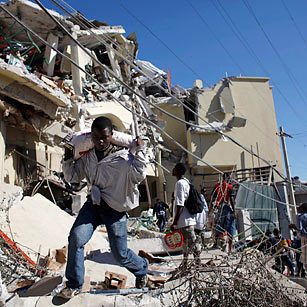 Louisiana became the 18th of the United States back in 1812, but you’d never have known it watching the Federal government’s ham-fisted response to 2005’s Hurricane Katrina. The Obama Administration is doing things differently: Haiti, for all intents and purposes, became the 51st state at 4:53 p.m. Tuesday in the wake of its deadly earthquake. If not a state, then at least a ward of the state — the United States — as Washington mobilized national resources to rush urgent aid to Haiti’s stricken people. “Our nation has a unique capacity to reach out quickly and broadly and to deliver assistance that can save lives,” President Obama said Friday. “That responsibility obviously is magnified when the devastation that’s been suffered is so near to us.”
Louisiana became the 18th of the United States back in 1812, but you’d never have known it watching the Federal government’s ham-fisted response to 2005’s Hurricane Katrina. The Obama Administration is doing things differently: Haiti, for all intents and purposes, became the 51st state at 4:53 p.m. Tuesday in the wake of its deadly earthquake. If not a state, then at least a ward of the state — the United States — as Washington mobilized national resources to rush urgent aid to Haiti’s stricken people. “Our nation has a unique capacity to reach out quickly and broadly and to deliver assistance that can save lives,” President Obama said Friday. “That responsibility obviously is magnified when the devastation that’s been suffered is so near to us.”
Obama has already dispatched a senior member of his national security team, Deputy National Security Adviser Denis McDonough, to the scene. An armada of U.S. warships is steaming toward Haiti, to be joined by at least one Coast Guard cutter en route from the Pacific via the Panama Canal — and manned and unmanned aircraft. Within two hours of the quake, one of the globe’s biggest warships, the carrier USS Carl Vinson, was ordered from off the Virginia coast toward Haiti, swapping its jet fighters for heavy-lift helicopters as it steamed south at top speed. Three ships, including the Vinson and the hospital ship USNS Comfort, boast state-of-the-art medical facilities that will care for injured Haitians. Thousands of troops are on their way to Haiti or already there, running the airport and clearing ports for many more to follow. Up to 10,000 troops will be in Haiti or floating just offshore by Monday.
It fell to State Department spokesman P.J. Crowley to clarify a delicate point: “We’re not,” he insisted, “taking over Haiti.” Strictly speaking, that’s true: Haiti remains a sovereign country, and there are 9,000 U.N. peacekeepers already there, charged with maintaining security. But as death stalks those smothered beneath the rubble of pancaked buildings, and poor sanitation triggers outbreaks of dysentery and other diseases, one nation in the world has the muscle to quickly make a difference. That’s why the U.S. is racing aid to the poorest nation in the Western hemisphere. If things get worse, the U.S. — fairly or unfairly — will be blamed by many for not doing enough.
Sometimes it takes a catastrophe to demonstrate just how much more the U.S. military is able to do than simply kill the enemy. Only the U.S. can initially control flights into and out of the Port-au-Prince airport from aboard a nearby Coast Guard cutter, while waiting for an Air Force special-ops team to set up shop at the airport and step up operations to 24/7. Only U.S. warships have the capability to generate up to 400,000 gallons of fresh water a day from seawater. Only the U.S. military can send a spy drone from California to fly lazy orbits over Port-au-Prince snapping close to 1,000 pictures a day, which when compared with similar ones shot last summer, create a map of the hardest hit areas that can be instantly relayed to those working on the ground.
Only the U.S. military has enough aluminum matting to boost the runway capacity of Port-au-Prince airport. Only the U.S. military has the surveillance capability to quickly assess additional Haitian airfields and seaports for use in rescue relief operations. Only the U.S. military has the wide variety of vessels and aircraft to utilize those fields and ports, including air-cushioned vehicles capable of ferrying 60 tons of supplies from ship to shore at 40 knots.
But the limits of U.S. capability can also be seen: The Pentagon diverted an unmanned Global Hawk drone bound for Afghanistan to Haiti instead, to photograph the damage there. “We were about to send that Global Hawk over to the war” until the earthquake, explained Air Force Col. Bradley Butz. “It will stay here until the President says it’s time to send it forward.”
While the drone had no comment about its sudden change of mission, some of those bound for Haiti welcomed the new assignment after more than eight years of war. “Marines are definitely warriors first,” Captain Clark Carpenter said Friday as his unit prepared to ship out to Haiti from North Carolina. “But we are equally as compassionate when we need to be, and this is a role that we like to show — a compassionate warrior that can reach out that helping hand to those who need it.”
Source: Time.com











[…] U.S. Military in Haiti: A Compassionate Invasion […]